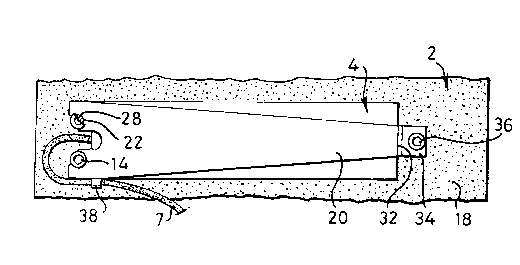Une partie des informations de ce site Web a été fournie par des sources externes. Le gouvernement du Canada n'assume aucune responsabilité concernant la précision, l'actualité ou la fiabilité des informations fournies par les sources externes. Les utilisateurs qui désirent employer cette information devraient consulter directement la source des informations. Le contenu fourni par les sources externes n'est pas assujetti aux exigences sur les langues officielles, la protection des renseignements personnels et l'accessibilité.
L'apparition de différences dans le texte et l'image des Revendications et de l'Abrégé dépend du moment auquel le document est publié. Les textes des Revendications et de l'Abrégé sont affichés :
| (12) Demande de brevet: | (11) CA 2248845 |
|---|---|
| (54) Titre français: | APPAREIL DE CHAUFFAGE |
| (54) Titre anglais: | HEATER |
| Statut: | Réputée abandonnée et au-delà du délai pour le rétablissement - en attente de la réponse à l’avis de communication rejetée |
| (51) Classification internationale des brevets (CIB): |
|
|---|---|
| (72) Inventeurs : |
|
| (73) Titulaires : |
|
| (71) Demandeurs : |
|
| (74) Agent: | KIRBY EADES GALE BAKER |
| (74) Co-agent: | |
| (45) Délivré: | |
| (22) Date de dépôt: | 1998-09-29 |
| (41) Mise à la disponibilité du public: | 1999-04-21 |
| Requête d'examen: | 1998-09-29 |
| Licence disponible: | S.O. |
| Cédé au domaine public: | S.O. |
| (25) Langue des documents déposés: | Anglais |
| Traité de coopération en matière de brevets (PCT): | Non |
|---|
| (30) Données de priorité de la demande: | ||||||
|---|---|---|---|---|---|---|
|
L'appareil de chauffage présenté comprend une pellicule chauffante 6 intercalée dans une feuille diélectrique 8. Un ressort à lame 20, qui est cintré au repos, serre l'élément intercalé contre une surface 18 à chauffer. L'appareil de chauffage peut être monté sur une surface interne du boîtier. Utilisant un élément chauffant souple spécialisé, on a fait fonctionné l'appareil de chauffage à une densité de puissance de 3,9 kW/m2. Dans l'appareil de chauffage, une face diélectrique souple est montée directement contre une surface interne du boîtier. Aucun usinage du boîtier n'est nécessaire puisque le diélectrique souple sert de joint thermique.
A heater is disclosed comprising a foil heating
element 6 embedded in a dielectric sheet 8. A a leaf spring
20 which is curved when relaxed, clamps the embedded element
against a surface 18 to be heated.
The heater can be mounted on an internal surface of
the enclosure. Using a proprietary flexible heating
element, the heater has been run at a flux of 3.9 kW.m2.
The heater is mounted with a flexible dielectric face
directly against an internal surface of the enclosure. No
machining of the enclosure is needed since the flexible
dielectric acts as a thermal gasket.
Note : Les revendications sont présentées dans la langue officielle dans laquelle elles ont été soumises.
Note : Les descriptions sont présentées dans la langue officielle dans laquelle elles ont été soumises.

2024-08-01 : Dans le cadre de la transition vers les Brevets de nouvelle génération (BNG), la base de données sur les brevets canadiens (BDBC) contient désormais un Historique d'événement plus détaillé, qui reproduit le Journal des événements de notre nouvelle solution interne.
Veuillez noter que les événements débutant par « Inactive : » se réfèrent à des événements qui ne sont plus utilisés dans notre nouvelle solution interne.
Pour une meilleure compréhension de l'état de la demande ou brevet qui figure sur cette page, la rubrique Mise en garde , et les descriptions de Brevet , Historique d'événement , Taxes périodiques et Historique des paiements devraient être consultées.
| Description | Date |
|---|---|
| Inactive : CIB de MCD | 2006-03-12 |
| Inactive : CIB de MCD | 2006-03-12 |
| Demande non rétablie avant l'échéance | 2001-10-01 |
| Le délai pour l'annulation est expiré | 2001-10-01 |
| Réputée abandonnée - les conditions pour l'octroi - jugée non conforme | 2000-11-27 |
| Réputée abandonnée - omission de répondre à un avis sur les taxes pour le maintien en état | 2000-09-29 |
| Un avis d'acceptation est envoyé | 2000-05-26 |
| Lettre envoyée | 2000-05-26 |
| Un avis d'acceptation est envoyé | 2000-05-26 |
| Inactive : Approuvée aux fins d'acceptation (AFA) | 2000-05-10 |
| Inactive : Demandeur supprimé | 2000-04-18 |
| Inactive : Correspondance - Formalités | 1999-10-29 |
| Inactive : Certificat de dépôt - RE (Anglais) | 1999-10-06 |
| Demande de priorité reçue | 1999-07-13 |
| Lettre envoyée | 1999-06-15 |
| Inactive : Transfert individuel | 1999-05-28 |
| Demande publiée (accessible au public) | 1999-04-21 |
| Inactive : CIB en 1re position | 1998-12-02 |
| Inactive : CIB attribuée | 1998-12-02 |
| Symbole de classement modifié | 1998-12-02 |
| Inactive : CIB attribuée | 1998-12-02 |
| Inactive : Lettre de courtoisie - Preuve | 1998-11-17 |
| Inactive : Certificat de dépôt - RE (Anglais) | 1998-11-10 |
| Exigences de dépôt - jugé conforme | 1998-11-10 |
| Demande reçue - nationale ordinaire | 1998-11-09 |
| Exigences pour une requête d'examen - jugée conforme | 1998-09-29 |
| Toutes les exigences pour l'examen - jugée conforme | 1998-09-29 |
| Date d'abandonnement | Raison | Date de rétablissement |
|---|---|---|
| 2000-11-27 | ||
| 2000-09-29 |
| Type de taxes | Anniversaire | Échéance | Date payée |
|---|---|---|---|
| Enregistrement d'un document | 1998-09-29 | ||
| Taxe pour le dépôt - générale | 1998-09-29 | ||
| Requête d'examen - générale | 1998-09-29 |
Les titulaires actuels et antérieures au dossier sont affichés en ordre alphabétique.
| Titulaires actuels au dossier |
|---|
| LUCENT TECHNOLOGIES INC. |
| Titulaires antérieures au dossier |
|---|
| MARTIN MICHAEL MARK KEEGAN |
| WILLIAM GEORGE GATES |